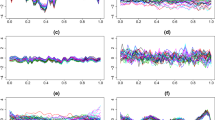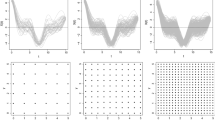Abstract
This paper is focus on spatial functional variables whose observations are a set of spatially correlated sample curves obtained as realizations of a spatio-temporal stochastic process. In this context, as alternative to other geostatistical techniques (kriging, kernel smoothing, among others), a new method to predict the curves of temporal evolution of the process at unsampled locations and also the surfaces of geographical evolution of the variable at unobserved time points is proposed. In order to test the good performance of the proposed method, two simulation studies and an application with real climatological data have been carried out. Finally, the results were compared with ordinary functional kriging.




















Similar content being viewed by others
References
Aguilera AM, Aguilera-Morillo MC (2013) Comparative study of different B-spline approaches for functional data. Math Comput Model 58:1568–1579
Aguilera AM, Aguilera-Morillo MC (2013) Penalized PCA approaches for B-spline expansions of smooth functional data. Appl Math Comput 219:7805–7819
Aguilera-Morillo MC, Aguilera AM, Escabias M, Valderrama MJ (2013) Penalized spline approaches for functional logit regression. Test 22:251–277
Caballero W, Giraldo R, Mateu J (2013) A universal kriging approach for spatial functional data. Stoch Environ Res Risk Assess 27:1553–1563
Chiou JM, Müller HG, Wang JL (2004) Functional response models. Stat Sin 14:659–677
Delicado P, Giraldo R, Comas C, Mateu J (2009) Statistics for spatial functional data: some recent contributions. Environmetrics 21:224–239
Dubrule O (1984) Comparing kriging and splines. Comput Geosci 10(2–3):327–338
Eilers PHC, Marx B (1996) Flexible smoothing with B-splines and penalties. Stat Sci 11:89–121
Eilers PHC, Currie I, Durban M (2006) Fast and compact smoothing on large multidimensional grids. Comput Stat Data Anal 50:61–76
Escabias M, Aguilera AM, Valderrama MJ (2005) Modeling environmental data by functional principal component logistic regression. Environmetrics 16:95–107
Faraway JJ (1997) Regression analysis for a functional response. Technometrics 39:254–261
Fernandez-Pascual RM, Espejo R, Ruiz-Medina MD (2015) Moment and Bayesian wavelet regression from spatially correlated functional data. Stoch Environ Res Risk Assess. doi:10.1007/s00477-015-1130-5
Ferraty F, Vieu P (2006) Nonparametric functional data analysis. Springer, New York
Giraldo R (2010) Geostatistical analysis of functional data. PhD Thesis, Universitat Politècnica de Catalunya, Catalunya
Giraldo R, Delicado P, Mateu J (2010) Continuous time-varying kriging for spatial prediction of functional data: an environmental application. J Agric Biol Environ Stat 15:66–82
Giraldo R, Delicado P, Mateu J (2011) Ordinary kriging for function-valued spatial data. Environ Ecol Stat 18:411–426
Giraldo R, Mateu J, Delicado P (2012) geofd: an R package for function-valued geostatistical prediction. Rev Colomb Estad 35:385–407
Goulard M, Voltz M (1993) Geostatistical interpolation of curves: a case study in soil science. Springer, Dordrecht, pp 805–816
Harville DA (1997) Matrix algebra from a statistician’s perspective. Springer, New York
Horvath L, Kokoszka P (2012) Inference for functional data with applications. Springer, New York
Hsing T, Eubank R (2015) Theoretical foundations of functional data analysis with an introduction to linear operators. Wiley, Chichester
Ignaccolo R, Mateu J, Giraldo R (2014) Kriging with external drift for functional data for air quality monitoring. Stoch Environ Res Risk Assess 28:1171–1186
Kaufman CG, Sain SR (2010) Bayesian functional ANOVA modeling using Gaussian process prior distributions. Bayesian Anal 5(1):123–150
Laslett GM (1994) Kriging and splines: an empirical comparison of their predictive performance in some applications. J Am Stat Assoc 89(426):391–400
Lee DJ, Durban M (2009) Smooth-car mixed models for spatial count data. Comput Stat Data Anal 53:2968–2977
Lee DJ, Durban M (2011) Pspline ANOVA type interaction models for spatio temporal smoothing. Stat Model 11:49–69
Marx BD, Eilers PHC (1999) Generalized linear regression on sampled signals and curves. A P-spline approach. Technometrics 41:1–13
Menafoglio A, Secchi P, Dalla Rosa M (2013) A universal kriging predictor for spatially dependent functional data of a Hilbert Space. Electron J Stat 7:2209–2240
Ramsay JO, Silverman BW (1997) Functional data analysis, 1st edn. Springer, New York
Rao CR, Rao MB (1998) Matrix algebra and its applications to statistics and econometrics. World Scientific Publishing Co., Pte. Ltd., Singapore
Reiss PT, Huang L, Mennes M (2010) Fast function-on-scalar regression with penalized basis expansions. Int J Biostat 6:1–28
Ruiz-Medina MD, Espejo RM (2012) Spatial autoregressive functional plug-in prediction of ocean surface temperature. Stoch Environ Res Risk Assess 26:335–344
Ruiz-Medina MD, Espejo RM, Ugarte MD, Militino AF (2014) Functional time series analysis of spatiotemporal epidemiological data. Stoch Environ Res Risk Assess 28:943–954
Ruppert D (2002) Selecting the number of knots for penalized splines. J Comput Graph Stat 11:735–757
Sangalli LM, Ramsay JO, Ramsay TO (2013) Spatial spline regression models. J R Stat Soc B 75:1–23
Shi JQ, Choi T (2011) Gaussian process regression analysis for functional data. CRC Press, Chapman and Hall, Boca Raton
Sigrist F, Kuensch HR, Stahel WA (2015) spate: an R package for spatio-temporal modeling with a stochastic advection–diffusion process. J Stat Softw 63:1–23
Ugarte MD, Goicoa T, Militino AF, Durban M (2009) Spline smoothing in small area trend estimation and smoothing. Comput Stat Data Anal 53:3616–3629
Yakowitz SJ, Szidarovsky F (1985) A comparison of kriging with non-parametric regression methods. J Multivar Anal 16:21–53
Zhang J-T (2013) Analysis of variance for functional data. CRC Press, Chapman and Hall
Zhang J-T, Chen J (2007) Statistical inference for functional data. Ann Stat 35(3):1052–1079
Acknowledgments
This research has been funded by Project P11-FQM-8068 from Consejería de Innovación, Ciencia y Empresa, Junta de Andalucía, Spain and the Projects MTM2013-47929-P, MTM 2011-28285-C02-C2 and MTM 2014-52184-P from Secretaría de Estado Investigación, Desarrollo e Innovación, Ministerio de Economía y Competitividad, Spain. we want to thanks Giraldo et al. by providing the R code related to Functional Kriging. Finally, we also thank the referees for the valuable comments on our manuscript. These comments helped to improve the organization and the understanding of our paper.
Author information
Authors and Affiliations
Corresponding author
Appendix
Appendix
Taking into account the following properties (Harville 1997)
the Eq. (5) can be rewritten as
with \(\Psi =\int \phi ^{T} \phi ^{T}\) being the inner product matrix between the basis functions. Next step is to compute the derivatives of Eq. (3) with respect to A. By considering the following properties (Harville 1997),
we have that
Then, A satisfies the matrix system of linear equations given by
In order to get the solution to A, the Kronecker product is used to express Eq. (9) in conventional matrix algebra
Then, Eq. (9) can be re-written as follows
where \(PEN_{d}^{U,V,T}\) is a P-spline penalty developed by Eilers et al. (2006), which is given by
Finally, A is given by
Rights and permissions
About this article
Cite this article
Aguilera-Morillo, M.C., Durbán, M. & Aguilera, A.M. Prediction of functional data with spatial dependence: a penalized approach. Stoch Environ Res Risk Assess 31, 7–22 (2017). https://doi.org/10.1007/s00477-016-1216-8
Published:
Issue Date:
DOI: https://doi.org/10.1007/s00477-016-1216-8




